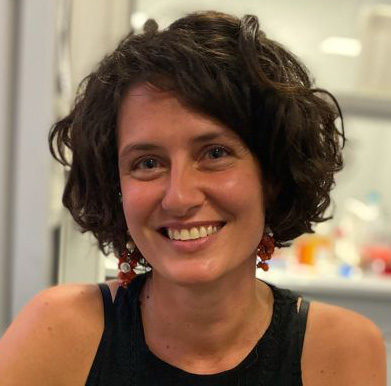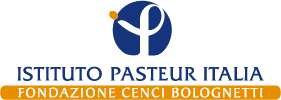Marialaura Petroni

Laureata in “Genetica e Biologia Molecolare” presso l’università degli studi di Roma “La Sapienza” (2007).
Ha conseguito il Dottorato di Ricerca in “Endocrinologia e Medicina Molecolare” (2011) ed è rimasta in qualità
di Post-Doc fino 2015, grazie al supporto di borse di studio finanziate dall’Istituto Pasteur Italia-Fondazione Cenci Bolognetti (Borsa Teresa Ariaudo) e dalla Fondazione Italiana per la Ricerca sul Cancro (FIRC). Successivamente, si è spostata presso l’Istituto Italiano Tecnologico Center for Life Nano Science (CLNS@Sapienza) di Roma fino al 2019.
Attualmente è Ricercatore (RTDA) presso il Dipartimento di Medicina Molecolare dell’Università degli studi di Roma “La Sapienza”.
Studio di nuove funzioni del gene NBS1 nello sviluppo e nella cancerogenesi cerebellare:
” Nostri dati recenti rivelano come NBS1, un fattore indispensabile nell’attivazione della risposta al danno al DNA (DDR), svolga un ruolo nella regolazione del cilium primario (CP), un organello essenziale per il corretto
funzionamento di molte pathway mitogeniche. Il nostro progetto ha lo scopo di valutare se questa nuova funzione di NBS1 sul CP sia dipendente dalla DDR, quanto contribuisca ai difetti neuronali associati alla deplezione di NBS1 nel topo e se sia deregolata nei pazienti con mutazione ipomorfica di NBS1 affetti da Nijmegen Breakage Syndrome (NBS). Lo studio contribuirà a comprendere il ruolo delle proteine della DDR nello sviluppo fisiopatologico del sistema nervoso rivelando nuovi possibili meccanismi molecolari alla base della NBS. “
Exploring new functions of the Nijmegen breakage syndrome gene in cerebellar development and carcinogenesis
NBS1 is a member of the MRE11/RAD50/NBS1 (MRN) complex, which plays an essential role in maintenance of
genome integrity and in the DNA damage response (DDR). Mutations in its gene lead to the Nijmegen Breakage
syndrome (NBS, OMIM-251260), a human DDR-defective syndrome characterized by immunodeficiency,
microcephaly and cancer predisposition. The neurological features of NBS patients have been modelled in a mouse with central nervous system (CNS) restricted NBS1 knock-out (Nbn-CNSdel mouse), which shows microcephaly, severe ataxia and cerebellar hypoplasia. In the cerebellum, the SHH pathway is the main driver of granule cell progenitors (GCPs) proliferation, but, if hyper-activated, also leads to transformation into medulloblastoma (MB). Strikingly, mice with CNS-conditional Sonic Hedgehog (SHH)-KO show a phenotype similar to Nbn-CNSdel mice, suggesting functional links between these pathways.
We demonstrated that NBS1-KO abrogates tumorigenesis in a spontaneous model of SHH-MB and impairs the growth of SHH-MB allografts. Moreover inducible NBS1-KO causes inhibition of the SHH-pathway in developing GCPs, in vivo and in vitro. While these data indicate that NBS1-KO is epistatic to the SHH pathway, they do not reveal how mechanistically controls SHH-pathway.
Given that: i) there is an emergent link between DDR and centrosome proteins; ii) NBS1 localizes at the centrosomes, prevents their hyperduplication and regulates centriole separation; iii) during interphase the centrosome converts into the basal body, which enucleates the primary cilium (PC); iv) the PC is essential for SHH signalling; v) MRE11 mutations are involved in ciliopathies; we hypothesize that NBS1 has a role in PC regulation, in addition to its canonical role on DDR. By disturbing PC function, NBS1-KO might impair SHH pathway with relevant consequences on development and tumorigenesis of the CNS and, in particular, of the cerebellum. In support of this hypothesis, preliminary data indicate that loss of NBS1 in primary GCPs cultures from inducible KO mouse model leads to PC deregulation.
Therefore, we aim to 1) prove that NBS1 function on PC is directly responsible for SHH-pathway inhibition; 2) prove
that PC and SHH dysfunction due to NBS1-KO are responsible for the observed cerebellar developmental defects and for MB inhibition; 3) evaluate whether NBS1 function on PC is dependent on DDR activation; 4) discover the
molecular mechanism underling the consequences of NBS1-KO on ciliogenesis; 5) disclose whether human NBSassociated mutations also lead to PC defects. To this end, we will generate new mice models with GCP-restricted NBS1-KO in the presence of SHH pathway hyper-activation dependent or independent from PC to disclose the relevance of PC dysfunction induced by NBS1-KO on both GCPs proliferation and transformation. We will also use novel genetically-engineered cell-based models to investigate how NBS1 directly or indirectly affects PC dynamics.
We strongly believe that disclosing and characterizing the emergent role of NBS1 on PC and SHH pathway will provide new insights into Nijmegen Breakage Syndrome and will increase our understanding of the role of DDR proteins in neuronal development and transformation.

Viale Regina Elena 291, 00161 Roma
Telefono: +39 06 49255625/6/7/8
Email: info@istitutopasteuritalia.it
PEC: pasteurcenci@legalmail.it
Codice Fiscale: 80201430586
